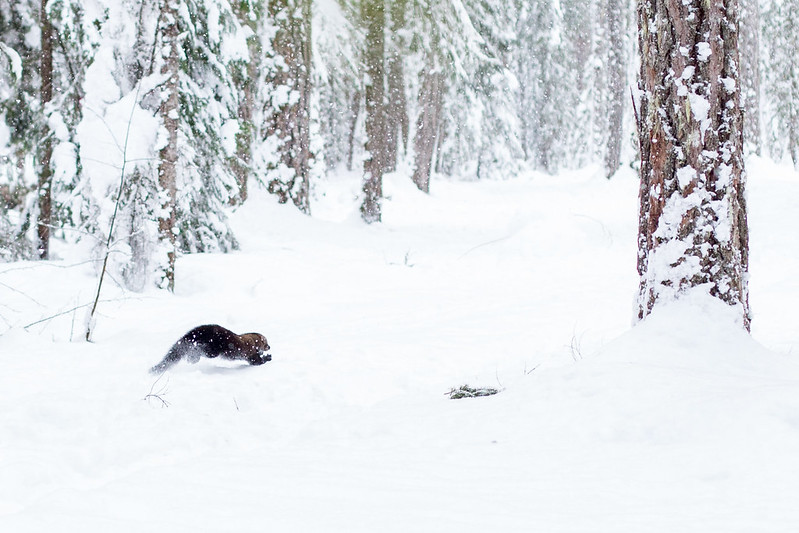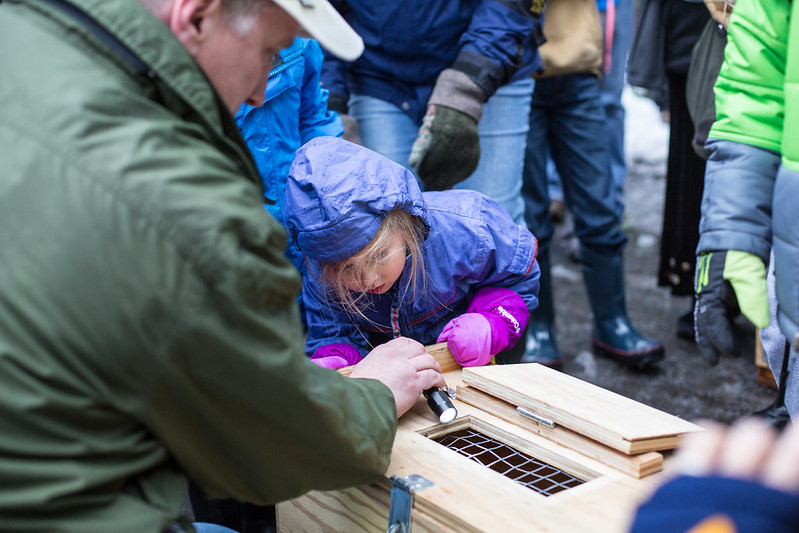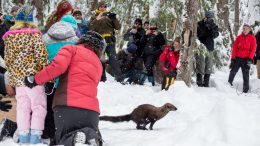There aren’t too many animals that will eat a porcupine for lunch, but fishers are at the top of the list.
Fishers (Pekania pennanti) are members of the mustelid family and a relative of otters, minks and martens. Quick on the ground and agile tree climbers, these forest dwellers couldn’t out-maneuver trappers in the 1800s, who relentlessly pursued the housecat-sized carnivores for their high-value pelts.
This overexploitation, combined with a loss of habitat from logging and other development, drastically reduced fisher populations across their ranges in the northern U.S. and Canada.
Some populations have rebounded, but on the West Coast, critically low numbers persist today. Despite that, most fishers lack protection; so far only one population in the Southern Sierra Nevada is federally listed as endangered.
A legal battle by a coalition of environmental groups (including The Revelator’s parent organization, the Center for Biological Diversity) seeking federal protections for Pacific fishers has dragged on for more than two decades.
In the meantime, the state of Washington has taken fisher recovery into its own hands. And as new trail cam footage of four kits in the Northern Cascades showed this spring, there’s cause for optimism.
I was able to extract some audio of one of Luna’s kits! Volume ⬆️. That’s the sound of a baby fisher at night in the North Cascades🥺
The still image shows her holding one up to the trail cam! Best guess is 4-5 weeks old.#restoration #carnivores pic.twitter.com/REdikxouNC
— Jason Ransom (@wildequids) May 20, 2021
Building a Recovery
The emerging population of fishers in Washington has been years in the making.
A wildlife survey in the 1990s confirmed that fishers had likely been extirpated from the state decades ago.
But some people refused to give up on the species. In 1998 fishers were added to Washington’s list of endangered species, and a few years later a feasibility study affirmed that local forests still held adequate resources for fishers. After that, the nonprofit Conservation Northwest, the state’s Department of Fish and Wildlife, the National Park Service, and other federal, tribal and nonprofit partners developed a plan to reintroduce the animals.
“We had the habitat, but we didn’t have the fishers. And there weren’t any nearby that could move into Washington and occupy these historical habitats,” says Jeff Lewis, a biologist with the state’s Department of Fish and Wildlife. “We identified three areas in the Olympics and Cascades that we really wanted to get fishers restored to, which were the bulk of their historical range in state.”
Between 2008-2010 biologists relocated 90 fishers from British Columbia into the Olympic mountains. Then the effort moved to the South Cascades with 81 fishers, mostly from British Columbia and a handful from Alberta. Finally, another 89 — this time all from Alberta — were released into the North Cascades beginning in 2018.
Researchers tracked the animals for the first several years with radio transmitters, then set up camera traps on the ground once potential dens were identified to see if the fishers were reproducing.
“What the data tells us for the Olympic population, for which we have the most information so far, is that the fishers are widely distributed, which is good,” says Lewis. “They’re reproducing, which is good. And they’re consistently occupying what appear to be good areas and they’re even using areas we didn’t expect.”
While the results are encouraging, it’s not a total slam dunk yet.
“The founding population involved fewer individuals than what would have been desired to have the level of diversity to ensure long-term sustainability,” says Dave Werntz, science and conservation director at Conservation Northwest. “So we plan to put another handful of fishers into the Olympics this winter.”
The researchers are still gathering long-term data on the two other Cascade populations. “We’re hopeful, and there are good initial signs,” says Lewis.
One of the reasons for that optimism is the fact that so much suitable habitat for fishers remains. But that’s only the case because conservationists stepped up in the 1990s to protect the northern spotted owl and the old-growth trees that fishers need, which resulted in the creation of the Forest Service’s Northwest Forest Plan.
“The plan set up a system of old-growth forest reserves and reserves along riparian areas for spotted owls that essentially caused the end of logging of the fishers’ preferred habitat,” explains Werntz. “That’s usually areas that have suitable den sites, which are generally big trees — either dead or live — with cavities. Those are typically found in their highest abundance in old-growth forests.”
Ecological Niche
Washington’s fisher rewilding effort has involved a partnership of different government and non-government agencies, years of work, and lots of public and private resources.
Lewis says the effort is worth it, for a number of reasons.
First, fishers are native members of the ecosystems and have unique qualities that can only be partially replaced by other carnivores.
“One of the most noteworthy things is that fishers are the most efficient carnivore of porcupines,” he says. “Where fishers have been eradicated through over-trapping or the loss of habitat, porcupine populations can explode and foresters get upset because they keep eating all the trees.”
Fishers also do all the other things that carnivores do: They poop; they spread seeds and pollen spores; they themselves are scavenged when they die, allowing their nutrients to come back into the soil. They also eat a number of prey species and can contribute toward ecosystem stability through all of those roles, he says.

“But to me,” Lewis adds, “there’s a bigger reason to do this work. Ecosystems are complicated and interconnected and we have a really limited understanding of how all the pieces work together,” he says. “So until we fully understand ecosystems, the best approach is what Aldo Leopold suggested: Let’s just make sure we keep all the parts when we’re tinkering with them. Let’s make sure we haven’t eliminated a role or a piece that’s important to the stability of an ecosystem. That to me is how I think of it relative to the fisher’s role.”
And there’s one more reason to restore fishers, too, he says. People overharvested fishers because of the value of their pelts, and now it’s possible to right that wrong.
“We have an opportunity,” he says. “We can bring this critter back because we have the habitat. When you look at fur-bearer conservation success stories, the bulk of those are ones where the species recovered after over-exploitation. Because you can fix that, you can stop trapping. You can move animals and restore populations in areas where they were extirpated.”
That’s harder to do for animals that have lost significant portions of their historical habitat, though.
“It’s awfully hard to restore habitat across the historical range of a species like the swift fox,” Lewis says. “That’s just a harder thing to do. You can’t restore grasslands to where they occurred in the 1700s and 1800s. But we can help fishers.”
Public Perception
Fisher restoration also presents an opportunity for public engagement in conservation — especially because many people haven’t even heard of fishers or seen one before.
“We try very hard when we’re doing the releases to make sure that kids are involved and it’s an educational opportunity and that they can experience the thrill of being involved in a recovery effort,” says Werntz. “That’s going to lead to an appreciation and a continued sense of wonder at nature that will carry with them throughout their lives.”

He says he’s encouraged by what he’s seen so far with the re-establishment of fishers in Washington.
One of the things that’s made the effort so successful, he says, is the partnership between nonprofits, government agencies and tribes. “Different partners can do things at different times,” he adds. It allowed them to raise money for a variety of sources, carry out work across the border in Canada, and get through some challenging political obstacles, including a government shutdown.
“That kind of diversity in coordination with partners really allowed us to be a resilient recovery team,” says Werntz. “And I think that cooperative coalitions may be an important model for future recovery work.”
And some of that work is already underway. Returning fisher populations to the state, it turns out, is just one of multiple efforts to restore native animals in the region. Conservation Northwest is also involved in other recovery efforts for grizzlies, gray wolves, Canada lynx and wolverines.
And like the spotted owl protection efforts benefitting fishers, there’s hope that native species reintroductions and restoration can have ecosystem-wide value.
“The notion is if you provide for those wide-ranging species, you’re going to be providing habitat and conditions for a whole suite of other organisms,” Werntz says. “And then you’re really enhancing biological conservation across the landscape. And that’s the underlying goal.”
![]()


